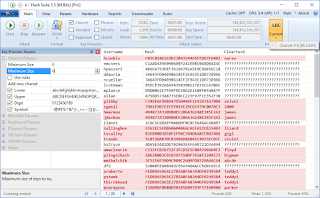Hash Suite 3.5.1 Pro Version Download (crack included)
Hash Suite 3.5.1 Pro Version Download (crack included)
Hash Suite is a Windows program to test security of password hashes. Main objectives are:Fast: We offer a program with very high performance.
Simple and modern: We use a simple GUI with features offered by modern Windows (fig 1).
Smart: Reports with statistics, easy download of quality wordlists, easily fix weak passwords.
Powerful: All common features of modern crackers and many unique to Hash Suite.
Scalable: Works fast even with a huge number of hashes.
Hash Suite 3.5 database file with 1 million NTLM hashes and 1 million LM hashes: 80MB
All hashes were randomly generated. The programs are sorted by average performance in first 4 columns. Performance is reported in hashes computed per second. For non-salted hashes (LM, NTLM, MD5, SHA1, SHA256, SHA512), this is the same as candidate passwords tested per second. For salted hashes (DCC, DCC2, SSHA, MD5CRYPT, BCRYPT, WPA), this is the number of candidate passwords tested per second multiplied by the number of hashes (all of which use different salts in these benchmarks). Results for salted hashes (where said multiplication was applied) are marked with asterisks (*).
Storing user passwords in plain text naturally results in an instant compromise of all passwords if the password file is compromised. To reduce this danger, Windows applies a cryptographic hash function, which transforms each password into a hash, and stores this hash. This hash function is one-way in the sense that it is infeasible to infer a password back from its hash, except via the trial and error approach described below. To authenticate a user, the password presented by the user is hashed and compared with the stored hash.
Hash Suite, like all other password hash crackers, does not try to "invert" the hash to obtain the password (which might be impossible). It follows the same procedure used by authentication: it generates different candidate passwords (keys), hashes them and compares the computed hashes with the stored hashes. This approach works because users generally select passwords that are easy to remember, and as a side-effect these passwords are typically easy to crack. Another reason why this approach is so very effective is that Windows uses password hash functions that are very fast to compute, especially in an attack (for each given candidate password).
DOWNLOAD LINK
